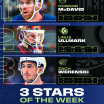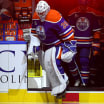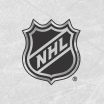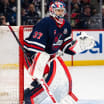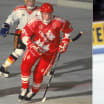BUFFALO - Patrick Monahan answered the phone in his suburban Toronto home 53 years ago this month; incoming Montreal Canadiens general manager Sam Pollock was on the other end of the line.
It was then Monahan learned that life was about to take a remarkable turn for his son. It just wasn't the son he expected, a father's surprise matching that of the teenager about whom Pollock was calling.
Monahan 'flabbergasted' to be historic pick
16-year-old center quietly became NHL's first-ever draft choice in 1963

Garry Monahan, then 16, made history in June 1963 as the No. 1 choice in the inaugural NHL Draft. He was the first player ever chosen in the quiet, half-century-ago precursor to the seven-round multimedia event that takes place Friday and Saturday at Buffalo's First Niagara Center.
"I was 16 at the time. What did I know?" Monahan via telephone this week from Vancouver, revisiting the occasion of being the NHL's milestone No. 1 selection.
"I didn't know there was a draft. Certainly my parents and my older brother, Pat, didn't know. The phone rang after the fact, and I don't even remember if it was the next day or the next week [that Pollock called]. We were all sort of flabbergasted."
Patrick Monahan quickly digested Pollock's news that Garry had just been drafted by Montreal, then asked his caller what the word "draft" meant.
"My recollection is that my dad told Sammy [Pollock], 'You mean Pat, Garry's [18-year-old] brother?' " Monahan recalled with a laugh. "Pat was the better player."
But indeed, it was Garry the Canadiens had selected.
Let's just say the 1963 NHL Draft (known then as the Amateur Draft) didn't have the profile of what will take place here this weekend.
On live television, 30 young men will be called to the stage of the Buffalo Sabres' arena Friday night in the first round of the 2016 NHL Draft, each pulling on the jersey of the team that has banked at least part of its future on his talent. Dozens more will be drafted the following day through the remaining six rounds. Some will have their dreams realized with a selection, others will be crushed when their names are not called.
Monahan was not at Montreal's Queen Elizabeth Hotel on June 5, 1963, when the NHL held a top-secret dispersal of junior-age players. It was the first time that teams could draft priority rights to these amateurs; until then, a player belonged to the NHL organization that sponsored his junior- or minor-league team.
A total of 21 players, all Canadian, were chosen by the six NHL teams. Coverage in the local English-language dailies was, well, underwhelming: The Montreal Star devoted four paragraphs to the draft; the Montreal Gazette ignored it.
Not that there was a whole lot to cover. The NHL held the draft behind closed doors, and it wasn't until some days later that the names of the drafted teenagers and the teams that selected them were announced.
Indeed, the whole process was a mystery even to many of those chosen.
Of the 21 players drafted, five made it to the NHL: Monahan; Peter Mahovlich, chosen No. 2 by the Detroit Red Wings; and Walt McKechnie (No. 6), Jim McKenny (No. 17) and Gerry Meehan (No. 21), all by the Toronto Maple Leafs.
There were few blue-chip prospects in the pool that June and for a few years to come because most of the best young players were already tied to NHL teams.
The 1963 draft, at the end of three days of NHL meetings, took a back seat to a quiet interleague draft that preceded it and a blockbuster trade on June 4 that saw the Canadiens send goaltender Jacques Plante and forwards Don Marshall and Phil Goyette to the New York Rangers for goalie Gump Worsley and forwards Dave Balon, Len Ronson and Leon Rochefort.
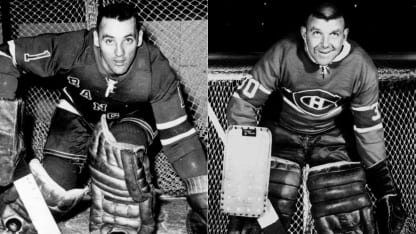
Monahan still chuckles at the secrecy of his draft, as he did nearly a decade ago when we first revisited it.
Not only did he have no idea he had been drafted, he was stunned a short time later to see Pollock and Scotty Bowman, then the Canadiens' head scout for eastern Canada, pulling into the Monahan family driveway in Scarborough, Ontario, on a business call.
The two executives laid out the teen's options: He could play with the Junior A Peterborough Petes, then managed by the Canadiens, or join the Junior Canadiens in Montreal. Patrick Monahan encouraged Garry to finish up at St. Michael's College School in Toronto, then play with the Petes.
"I'd been thinking, 'I'm a third-line guy. Drafted? What the heck is this? I'm not very good,' " Monahan said, remembering that he was more bewildered than disappointed to be drafted by the Canadiens while growing up in the heart of Maple Leafs country.
Hockey hadn't even been on the radar of the teen, who tried out for the St. Mike's bantam club on a whim and made it. Skating two years ahead of himself as a tag-along on brother Pat's minor-league teams, he was a third-liner at best.
Only at 19, in his third and final season with the powerhouse Petes, did Monahan emerge from the shadows, scoring 30 goals finishing with 84 points in 47 games.
He graduated from the Petes in the spring of 1967 and reported "scared skinny" that fall to the Canadiens training camp at the Montreal Forum.
Monahan recalled dorm-style living with maybe 20 fellow hopefuls in the windowless basement of a downtown hotel, battling with fellow rookie Jacques Lemaire for the team's fourth spot at center.
"Jean Beliveau, Henri Richard, Ralph Backstrom and Lemaire at center. They were pretty deep in talent," he said.
Monahan was one of the few left standing when camp broke and bodies were sent to the Central Hockey League's Houston Apollos or back to their junior clubs, "and it was then that it became very intimidating, with Toe Blake the coach and Jean Beliveau the captain."
He was paid $8,000 to sign and $10,000 for the season, riches he'd never imagined. His wife-to-be, Barbara, was earning $4,000 as a teacher.
Monahan spent more time with Houston than Montreal during his two seasons with the organization. He played in 14 NHL games, though he recalls practicing during the postseason with the Canadiens when they won their 15th and 16th Stanley Cup championships in 1965 and '66.
There were tough moments, but even those remain fond memories.
Monahan remembers largely fending for himself, nearly missing an overnight train to New York and then unknowingly crawling into a lower berth that was reserved for Beliveau. He also recalls hobbling onto a team bus on a foot nearly broken, then being verbally undressed by Blake for arriving 30 seconds late.
By now, Lemaire was on his way to stardom and Monahan was a commodity. Pollock packaged him to Detroit with Doug Piper on June 6, 1969, for Mahovlich, a former teammate at St. Mike's, and defenseman Bart Crashley.
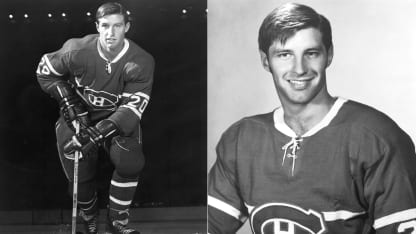
It was six years and a day after Pollock had drafted Monahan into the NHL.
"Sammy finally realized his mistake," Monahan joked, "so he traded me for Peter."
Molded into an efficient checking center, Monahan ended up playing 734 NHL games for the Red Wings, Toronto and the Vancouver Canucks.
"I left Jean Beliveau in Montreal and arrived beside Gordie Howe in Detroit," said Monahan, 69, who was given sweater No. 11 with the Red Wings.
"You sat in the dressing room according to number," he said, "so there I was beside Gordie, No. 9, and Alex Delvecchio, No. 10."
Hockey eventually took Monahan to Japan, where he absorbed a new culture for three seasons while skating for a company team in Tokyo, before he returned to a business life in Vancouver. He retired a few years ago from a career in real estate, having done radio work for the Canucks and been involved in stock brokerage.
Monahan is still active with the Canucks alumni, practicing every Wednesday night during the winter and playing a handful of games around the province, and "trying to stay in shape" while working on his golf and tennis games in the summer.
He attends a good number of Canucks games, rubbing elbows with the former players who come in with visiting teams as he tries, with little success, he says with a laugh, to keep abreast of revolving-door NHL rosters.
And more than half a century later, Monahan still gets a kick out of how he arrived in professional hockey under cover of darkness, and says he "might cast an eye" on Friday's flood of spotlights that will bathe the NHL's new crop of high-profile young talent.

